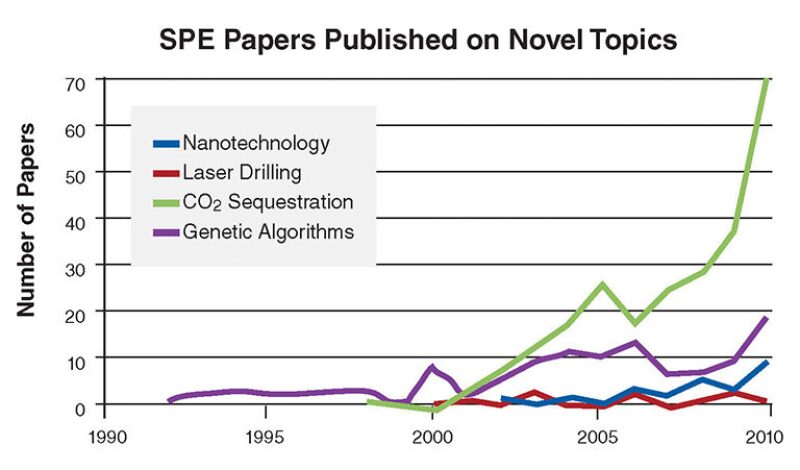This is the second installment in a two-part series on how to write an SPE technical paper. The first installment was published in TWA Vol. 7, Issue 2, 2011.
The previous installment of SPE 101 focused on how to write a high-quality SPE paper—what makes a worthy topic, what preparation is required, and what authors can do to make their papers shine. This article focuses on the value proposition, explaining how papers provide documentation of technology from its infancy to its widespread acceptance.
For an author, publishing and presenting a paper may feel like the end of a finite block of work. In reality, however, a well-prepared paper keeps on giving as time goes on. How so? Let us look at some examples using a few technologies in varying states of maturity. Fig. 1 was generated using a topical search for SPE papers at onepetro.org, the electronic technical paper library. The number of papers published about a given topic is a good indicator of the progress of the technology over time. An academic theory or idea will evolve in progressive phases, starting in research, then on to early field trials, refinement, and ultimately widespread use. As the concept matures, there is a corresponding change in the number and types of papers published. Note the rapid uptake of CO2 sequestration compared with the steady growth of nanotechnology and genetic algorithms. In contrast, laser drilling has not yet been commercially applied, and it is represented in the literature by a few papers presenting the steady progress of research since the late 1990s. Throughout the development of a technology, there are “landmark” papers—those that set themselves apart because they are well-written summaries of the state of the art. These are the kinds of papers author should aspire to write.

Once your paper has been loaded onto the OnePetro website, its impact will begin to grow. Other professionals interested in your topic can perform a quick search that will lead them not only to papers, but to other information as well. The OnePetro search tool also provides a summary of people or companies that generate the most hits in a query. A modest amount of search can confirm which authors and organizations have been involved in the development of a given technology from the outset. Whether or not you have written a “landmark” treatise, a well-written paper (and the work behind it) has answers the industry needs, and a reader may identify your experience as having unique value. Using the SPE member directory, a colleague may contact you to ask for an informal update on the technology, or might ask for additional contacts to network with. As an author, you may be asked to provide a referral for products or services that may be helpful to those seeking to apply the technology or technique. When dealing with colleagues outside your company, be sure to follow your employer’s intellectual property policy.
It is important to remember that an author’s responsibilities continue long after a paper is published. Putting one’s name in the society’s literature signifies an ongoing commitment to share technology for the good of the industry. For readers, these groundbreaking papers offer insight on the potential as well as the limitations of new technology. Technological limitations are important topics for future authors—these represent areas to work on and may be ideal topics for future papers.
So what does this mean for a potential author? As you prepare to write, consider how your paper will contribute to the existing body of literature. Are you doing groundbreaking work on a novel topic? Giving a “state of the technology” update? Are you writing about an innovative application of a mature technology? Check onepetro.org to be sure that you are not duplicating what has been written. You will find that your papers are more valuable to the industry—the kind of contribution that brings great personal satisfaction and possibly long-term professional recognition.

